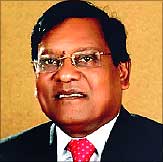 Indian Oil Corporation (IOC) has come a long way in its 50 years of existence. So far, it has been primarily known as a petroleum company.
Indian Oil Corporation (IOC) has come a long way in its 50 years of existence. So far, it has been primarily known as a petroleum company.
But IOC is now gearing to become an energy company by foraying into new sources of energy, such as wind and nuclear. Chairman Sarthak Behuria speaks to Ajay Modi on IOC's future plans, the suggestions made to Kirit Parikh Committee and the way forward. Edited excerpts:
What is your vision for the company?We should be one of the energy companies of India and not be confined to the hydrocarbon sector. Earlier, our vision was to be in upstream and downstream. But then we felt that we have not done much in other forms of energy. Now we want to make a foray beyond the downstream and upstream sectors into the new vistas of energy.
We want to emerge as a global energy entity riding the wave of deregulation. We want to make our presence felt in as many countries as possible, either in exploration and production (E&P), retail, downstream, marketing or refinery.
Which are the new areas of energy IOC is looking to foray into?
We are venturing into petrochemicals. We have tied up with NPCIL for nuclear power generation. There is a guaranteed return and enough opportunity for all of us. It will enable us to enter new vistas of energy business. We are already into wind power and looking to foray into solar power.
Is there any acquisition on the cards?
We have plans to acquire some mid-size E&P companies overseas in partnership with Oil India Ltd in Africa and Latin America. This acquisition could be in the range of $500 million (nearly Rs 2,300 crore). We are not that excited to acquire a refinery or a marketing company.
Crude oil prices have remained highly volatile last year. How do you see things going forward?
Recently, we have seen a spurt in prices. Going forward, oil will be stable but I do not think it will be low. Prices will remain in the $75-85 a barrel range. These are rates we have to accept.
So, you do not see prices touching $100?
It depends on the supply-demand situation and how the financial market corrects itself. A lot of money goes into futures and speculative trading.
How is the financial situation of the company, given the high under-recoveries on LPG and kerosene oil?
We are better off than last year. Crude prices are reasonable, under-recoveries are comparatively lower. We have borrowings but we also have a fairly large amount of bonds, almost worth Rs 30,000 crore. Still, we are not that healthy in the sense that we are not a debt-free company and we have under-recoveries, which will be around Rs 27,000 crore for the year. But, we have seen much worse days.
When you say this, do you mean you are well-funded to carry out all the expansion projects? Or is funding an issue?
There is no problem in funding. But, going forward, we expect our profits to be maintained in the range of over Rs 8,000 crore in order to ensure funding since most of our projects are from internal accruals. We have also tied up debt worth Rs 14,500 crore for the Paradip project. We have projects worth Rs 60,000 crore to be carried out in the next five years. Beyond that, we have to see.
What kind of suggestions has been made to the Kirit Parikh Committee?
We have suggested that petrol and diesel prices should be market-driven because refinery gate prices are market-driven, crude oil prices are market-driven. As far as kerosene and LPG are concerned, the subsidy should be met out of the budget. As a marketing company, we would like to be compensated for anything we are selling below cost.
Are you prepared to comply with Euro-IV and Euro-III blending norms from April?
We should be ready for Euro-IV from the stipulated date. However, there could be some slippage in meeting Euro-III norms in some pockets. The first three-six months is going to be tough. We might have to import some diesel as well, because overall demand is growing.
Last year, we saw airline companies defaulting on ATF payments. Has the situation improved?
The prices of ATF (aviation turbine fuel) have stabilised compared with last year. We extended some credit, as airlines were going through very bad days. But, from the Indian Oil perspective, dues of airline companies are under control. They are seeing better days. Traffic is going up.